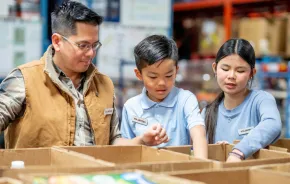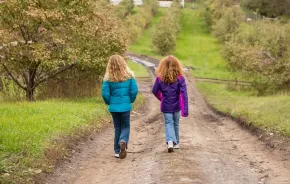
At the top of most parent’s list of character traits they wish to instill in their children, empathy and kindness always rank near the top.
But they're incredibly difficult topics to introduce to toddlers who only understand the "me mentality." Just a few short years ago their needs were being met on-demand and they aren’t fully in control of their own emotions yet, let alone being able to recognize what others may be feeling.
How can you effectively teach empathy to toddlers who are much more interested in looking out for themselves? Here are five ways to teach empathy to toddlers that I’ve used with my two kids.
Think outside the box.
I recently found the sweetest subscription box service that has helped me introduce empathy to my kids in a fun way. Outside the Box is different from the typical subscription box for kids because all of their activities includes an aspect of giving back to those in need. The activities come with conversation starters to help parents introduce the activities to their kids as well as share about those who will be benefiting from the outcomes.
Our package from Outside the Box benefited those who were impacted by Hurricane Harvey. Inside the box was an activity where my kids decorated pillow cases that were then returned to Texans who lost their home in the hurricane. There were two copies of the same children’s book in our box, one for us to keep and the other for my kids to write a note of encouragement inside and send back to children who may not have any books with them if their belongings were destroyed.
The conversation starters that came in the box were extremely helpful as I shared with my kids the situation that many families, just like us, are facing because of this tragedy. Questions like "How would you feel if you suddenly lost all of your books and toys?" or "Why should we help families who have had to leave their homes?" I didn’t have to fumble over the right things to say. Instead, I started with one of the suggested questions and let the conversation flow from there.
Watch TV — ask questions.
Books, videos on YouTube and TV shows are all great places to start talking to toddlers about empathy. Yes, many kids programs today focus on kindness, but you don’t know if your children are receiving the intended message unless you ask them about it.
After watching a movie or show with my kids, I will try to follow up with questions to gauge their overall understanding of what they just saw. Questions like, "Why do you think she was sad when that happened?" or "What could he have done differently?" are great to kick off the conversation. Don’t assume that just because they were zoned out during the program that they truly understood those subtle life lessons.
Care for animals.
Another easy way to instill empathy in a child is through their interactions with animals. Caring for an animal requires the acknowledgment that they have a need and you can provide it for them. Having a child become more active in caring for a family pet is a great way to help bring this concept to life.
It can be as easy as putting them in charge of scooping food in to a dish and explaining how they are helping meet the nutritional needs of the animal. If you don’t have a pet, you can head to the zoo and watch the zookeepers feed the animals or clean out their habitats. Share how important it is to provide the animals with the care they can’t provide themselves.
Teach kind.
Teaching kind habits to children starts to remove the "me mentality" from always being top of mind. These habits can include opening doors for others, helping unload groceries, cleaning up toys at the end of the day and putting their laundry away. These may seem like your everyday type of chores, but if you explain to them how it is helpful to you personally they will start to understand that it’s more than that.
I always praise my kids when they help me complete a task like putting dishes away but additionally I share why it’s so helpful to me because it saves me time.
Discuss differences.
Toddlers have a knack for being blunt in their observations of the world. This can be awkward at times, but often these situations can serve as a great learning opportunity. If your toddler points to someone in a wheelchair and asks about it, don’t shy away from it. Discuss it!
Often, the other party may be very willing to chat with your child about how life might be a little bit trickier sometimes and how important it is to help one another. And the next time they see someone in a similar situation that curiosity might just change to action.
Remember that toddlers are still working through their own thoughts and emotions and empathy is something that will take time for them to understand. But don’t miss out on easy everyday opportunities to introduce the concept!











